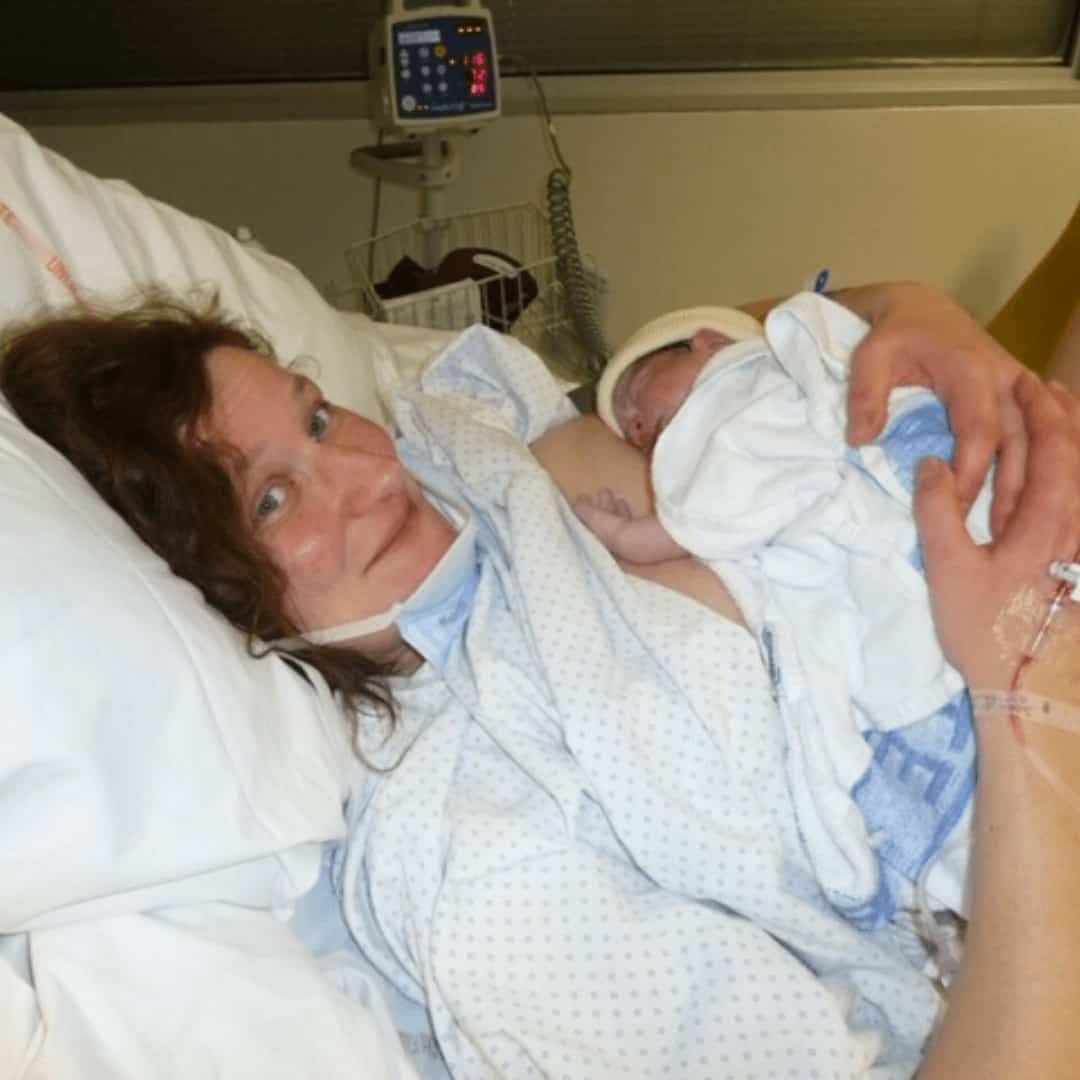Birth stories often fall into two categories: lovely and full of warmth and downright horrifying. In fact, we’ve published several birth stories that run the gamut from joyful to petrifying. Unfortunately, Melanie’s story falls into the latter category. A German mama living in France, Melanie gave birth to her child in a French hospital where her medical team performed an episiotomy without telling her or asking for permission. This ultimately led to a traumatic birth story in which Melanie remembers mostly violence. Not to mention that, 10 years later, she still experiences painful sex after episiotomy.


This site contains affiliate links, meaning that we earn a small commission for purchases made through our site. We only recommend products we personally use, love, or have thoroughly vetted.
What is a Traumatic Birth?
Did you know that there’s an actual organization for the Prevention and Treatment of Traumatic Childbirth (PATTch)? PATTch “envision[s] a world where women, infants and families experience optimal physical and mental health in pregnancy, childbirth, and post-partum.”
This organization is doing important work because, according to their website, “between 25 and 35 percent of women report that their births were traumatic.” Read that again.
25-34% of women have traumatic births.
PAATch defines traumatic birth as occurring “when the individual (mother, father, or other witness) believes the mother’s or her baby’s life was in danger, or that a serious threat to the mother’s or her baby’s physical or emotional integrity existed.”
Compromising physical and emotional integrity is exactly what happened when Melanie’s medical team performed an episiotomy without her permission or even letting her know that they were about to do so.
Melanie’s Traumatic Birth Story
My first birth was not only my longest; it also had the most devastating effects on my life. This is a story full of pain and violence. It’s a story in which my right to choice did not exist and my body was forever damaged due to a decision I was not allowed to make.
It started 21 days before my due date, when my amniotic sac burst. It was not a gush, but a fine stream.
I drove to the hospital because I knew I was three weeks early. I needed to feel in control of the situation.
The hospital staff said, “We will keep you here. When you leave the hospital again it will be with your baby in your arms.”
Then we had to wait and see what would happen.
Labor began, and my contractions were painful but unfortunately not strong enough to open my cervix. The doctor decided to wait for 24 hours to see what would happen.
As we waited, my midwife checked me frequently to find out how many centimeters I had dilated.
Her checks were extremely painful, as she had quite short fingers and had to press and push hard to get to the cervix.
When I requested that another midwife check me, I was told that this was not possible, despite experiencing unnecessary pain from my cervical checks.
Aside from feeling out of control when my water broke, this was the first time I began to feel like I wasn’t empowered during my birth experience. Click here to learn more about patient empowerment during childbirth.
After 26 hours of contractions, my medical team finally decided to apply gel to my cervix to intensify the contractions.
It worked.
I Was Traumatized by an Episiotomy I Didn’t Approve
In the delivery room I had an epidural, which only worked on one side. I was told, “that happens sometimes…”
Have you ever had one-sided contractions? It is NOT pleasant.
The whole reason I wanted an epidural was so I could enjoy birth. Experiencing contractions on one side wasn’t what I had envisioned, to say the least.
Katy also experienced an epidural that only worked on one side, but her anesthesiologist increased her dosage and changed the position she was in until the epidural was fully effective.
My doctors made no effort to improve my experience with an epidural.
Shortly before the actual birth, I felt that the midwives were doing something unexpected. They were cutting.
I asked what they were doing, they informed me that they had performed an episiotomy.
Episiotomies used to be a fairly normal part of childbirth (bless those women before us). According to the Mayo Clinic, “for years an episiotomy was thought to help prevent more extensive vaginal tears during childbirth–and heal better than a natural tear. […] Today, however, research suggests that routine episiotomies don’t prevent these problems at all.”
My midwives actually told me that because I have red hair and very light skin, they performed an episiotomy without my consent to prevent tearing.
I was not asked but simply confronted with an accomplished fact.
[Editorial note: episiotomies are performed during emergencies, such as when the baby’s shoulder is stuck behind the pelvic bone or there is an abnormal heart rate pattern. Melanie’s episiotomy was presented to her as “routine,” something done because she looked like she would tear easily.]
36 hours after the rupture of the amniotic sac, my son was born. He was 2760g and 49.5cm (approximately 6 lbs, 19.5 inches).
He was rather dainty, perhaps nothing would have been torn at all. For comparison, Katy experienced only a first degree tear with Jack, who was half a pound larger.
The Aftermath: Painful Sex After Episiotomy
This unwanted, unsolicited episiotomy has had devastating effects on my sex life even until today–almost 10 years after the birth of my son. Sex after episiotomy to this day remains uncomfortable.
I have largely lost the joy and pleasure of sex because I still feel the scar.
During sex, the scar rubs and is disturbed. It’s not just uncomfortable; it downright hurts.
10 years after birth, this scar haunts me and my sexual partnership. And the scary fact is that it was neither necessary nor did I give any consent to have it.
It is incomprehensible to me how something like this can happen. I was cut into without being asked for my approval. My episiotomy was performed to make my birth easier for my medical team, not for me.
There was no consideration for my emotional or physical well-being, or for the potential long-term ramifications of an episiotomy.
My takeaway from this “routine” and incredibly invasive procedure that has scarred not only my body, but also my sexual partnership, is that my choice in the matter was unimportant.
Is Sex the Same After Episiotomy?
For me, the answer is obviously no. It never has been. This is one reason women need to be informed about how decisions made in the delivery room can affect them long-term. This is one of the many reasons choice, when possible, is essential.
But I’m one case. Some women’s sex lives do return to normal after an episiotomy, but episiotomy leads to an increased likelihood of painful sex.
John Fisch, a Pittsburgh-based OBGYN, told USA Today that “there is more potential for pain with intercourse” when a woman receives stitches after birth. Stitches are always necessary after episiotomy.
According to the same US Today article,”About 20% of women who receive stitches experience painful sex for six months after delivery. In some rare cases, the pain lasts longer.”
This is not a time when I’ve ever wanted to be “rare.”
But while my experience may be rare long term, it is very common in the short term. According to the UK’s National Health System, “9 out of 10 women who have had an episiotomy reported resuming sex after the procedure was very painful, but pain improves over time.”
The word “improves,” though, is concerning. Is the pain actually going away, or are women merely reporting improvement, not complete recovery, while continuing to live through painful sex?
Tips to Avoid an Unnecessary Episiotomy
While episiotomies may not be routine anymore, they can still be necessary during a medical emergency.
Here are my tips to avoid having an unnecessary episiotomy:
- Do your homework. Understand what an episiotomy is and why they are usually performed. Familiarize yourself with the labor emergencies that usually require episiotomies. Arming yourself with this information will allow you to know when you might actually need one and when your medical team might be performing a “routine” episiotomy.
- Have a firm birth plan. While birth plans can sometimes go out the window during emergencies or other issues during birth, having a birth plan that your medical team is aware of–and that makes you feel empowered–is essential. In your plan, include that you and your partner want to be consulted at every step, including before an episiotomy. Give your partner the right to make decisions if you are unable to do so, and tell them ahead of time what preferences you have about those choices!
- Take steps to avoid an episiotomy. The American Pregnancy Association recommends the following steps to avoid an episiotomy:
- Practice good nutrition while pregnant, as healthy skin stretches more easily
- Do kegels to stretch your pelvic floor muscles
- Ask your doctor for a slowed second stage of labor where pushing is controlled
- Use warm compresses and support during delivery
- Use perineum massage techniques
- Avoid lying on your back while pushing
Hopefully, you will not have to experience the violence of an unnecessary and un-asked for episiotomy in the year 2019, but if you do, know that there are many women out there who you can seek out for support, including the Undefining Motherhood community.
More Birth Stories About the Need for Patient Empowerment and Choice
- Jade’s story of the disadvantages of natural birth. She felt pressured into a natural birth she didn’t want, and her lack of choice had serious emotional consequences.
- Aisha’s story of a complicated third pregnancy and the benefits of patient empowerment for African American mothers. She explains tough statistics that show why black mothers are at an especially increased risk for childbirth-related complications. This information is important to everyone, and her advice is applicable to everyone!
Did you experience a traumatic birth story or painful sex after episiotomy? Tell us your experience in the comments.
_________

Melanie is 44 years old. She was born and grew up in Germany, but moved to France in 2003 for work, where she still lives today. She is the lucky mother of 2 living boys, an adorable stepdaughter, and of a baby boy in Heaven. Between the birth of her 2 sons, she experienced 6 years of hope and sorrow in which she lost 4 pregnancies. She is grateful for her children–those I can hold at her hand and in my heart. They remind her to love life, enjoy the moment, and not take unimportant things too serious.
She hopes her story can help educate and empower other women so they can have more positive birth experiences. If your German is proficient, she runs a great and informative Instagram account at @mellamel1975, writing about miscarriage, stillbirth, life, and raising children who grow up with their lost brother as a member of the family.
Other Pregnancy Articles
- Unusual early pregnancy signs
- When to announce a pregnancy on social media, to family/friends, & at work
- Pregnancy care package
- Hospital bag checklist printable
- Birthing checklist (how to write a birth plan)
- Getting ready for a baby checklist
- Baby registry must haves
- How to prepare for labor induction
Trying to Conceive Articles
- Best way to track ovulation
- TTC tips
- 2ww ttc (surviving the two week wait when TTC)










